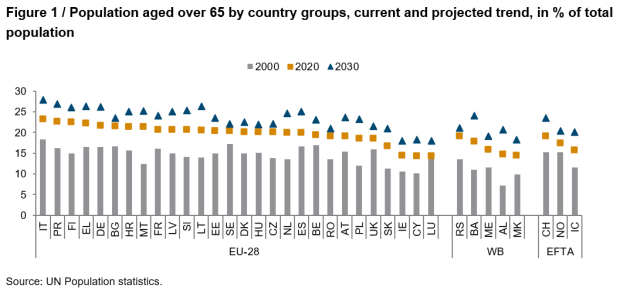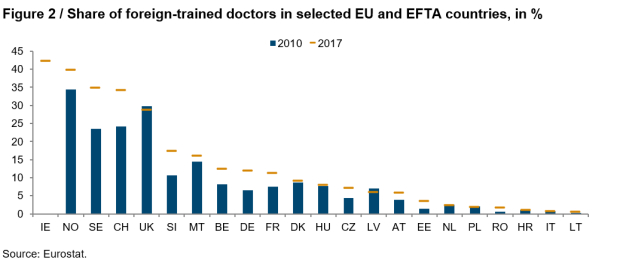Chain mobility of health professionals among European countries
17 June 2020
Imbalances in the supply and demand of health professionals are prevailing among European countries.
by Isilda Mara
photo: iStock.com/gpointstudio
- Satisfying the demand for health professionals is becoming increasingly challenging.
- Hiring foreign-trained health professionals has been the quickest solution to tackle such shortages, but this will not be enough in the long run.
- The COVID-19 emergency has highlighted the need for greater investment by all European countries in their health systems and health personnel.
Demand and supply of health professional: imbalances are prevailing
The retirement of baby boomers, the rise in life expectancy and the ageing of the population are all warning signs that the demand for health professionals is bound to expand. Now COVID-19 has shown how exposed European countries are in the face of a health emergency. A recent wiiw study, focuses on the imbalances in the supply and demand of health professionals among European countries. Also it contributes to a better understanding of the mobility patterns of health professionals, why some countries are more successful at attracting health personnel than others, which are the main receiving and sending countries of health personnel in Europe, what drives this mobility, and how does it affect the availability of health workforce in the respective sending and receiving country.
Mobility of health professionals: winners and losers
An interesting “paradox” emerging from the wiiw study is that for a number of European countries a high density of health graduates goes hand in hand with a low density of the health workforce. This is a pattern which might be explained by the cross-border mobility of health professional in Europe. Slovakia, Hungary, Croatia and Romania, in particular, have a higher density of graduates – among both doctors and nurses – than the EU average, but their health workforce availability is below the EU average.
The continuous battle to attract health professionals from other countries has been affecting a number of European countries in a good as well as in bad sense. Hiring foreign-trained health professionals has been beneficial for some European countries, but it has created imbalances in others. What is striking is that this battle is expected to become increasingly tenacious as long as the European countries fail to coordinate their efforts towards long-term solutions.
Drivers of mobility: better earnings prospects but also language affinity foster mobility
The analysis of what drives mobility and how it affects the availability of health workforce in the respective sending and receiving country has been also revealing. Gravity modelling estimates suggest that better earnings prospects, but also geographical proximity and language affinity, matter for health professionals’ mobility.
Ways forward
The Covid-19 emergency has confirmed that all EU countries have weaknesses in their health system. Accordingly, new policy instruments should be introduced and better coordination and management at the EU level should be advocated with the aim of making the mobility of health professionals beneficial for both receiving and sending countries. A win-win solution might be the adoption of international exchange programmes which promote short-term or circular rather than long-term or permanent migration among health professionals. Automation and technological solutions, rather than substitution, are complementing and supporting health professionals in their work. Automation of certain health services is gaining ground and might become an extremely useful alternative, especially in rural and remote areas, where health professionals are not easily accessible.


